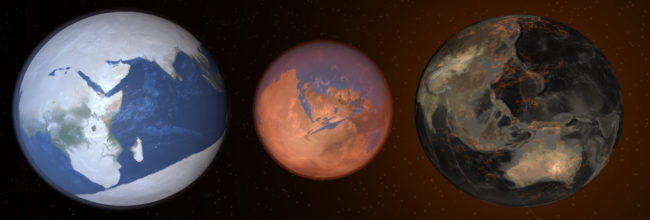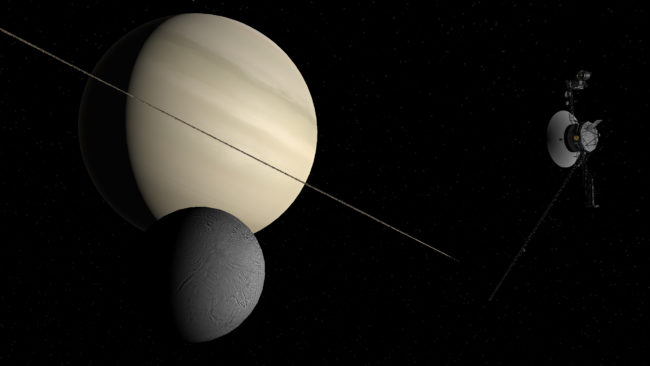Archive for April, 2017
Hiring a Simulation & Climate Developer
Apr 30th
This position has been filled. Thank you to everyone who applied.
If this still sounds like an ideal job for you, please reach out. We are always looking for more help from the right candidates.
Giant Army is looking for someone with a strong background in both software development and physics to join our team and help improve Universe Sandbox ².
You will work with our team’s scientists and developers to create and improve real-time geophysical and astrophysical simulation. Your role is crucial in ensuring the scientific accuracy of simulations in Universe Sandbox ².
We strongly prefer a candidate with practical implementation experience over one with a high-level, theoretical background. In other words, we’re looking more for a good developer with an interest in science, rather than a good scientist with an interest in software development.
This is a full-time, remote position.
Join us. We’re making something incredible that’s unlike anything else.

Your Initial Role
- Work with our team’s scientists and director to define a problem and iteratively determine the best numerical solution that meets computational constraints
- Quickly prototype new ideas and estimate computational costs
- Examples of simulation improvements needed:
- Real-time generic climate modeling (calculating temperature, pressure, greenhouse effect, terraforming, etc.)
- Planetary composition and material system (metallic hydrogen in gas giants, simulating subsurface oceans on moons, etc.)
- Simplistic life simulation that impacts the atmospheric composition of planets (extinction events, spread of life across a planet’s surface)
Ideal Candidate
- Experience with practical physics programming
- Loves physics simulations and fantastical what-if scenarios: what-if.xkcd.com (note citation #6 on 148)
- Excited about developing a tool that allows users to experiment with simulations, pushing the boundaries of what has been done in real-time for public consumption
- Experience working with Unity
Mandatory Qualifications
- Developer with C# and C++ experience
- Solid grasp of computer science topics and algorithms
- Solid understanding of mathematics and physics (ideally bachelor-level or higher)
- Experience with writing efficient, real-time, interactable code
- Ability to take complex concepts and models and condense them into performant code
- Passion for sharing science and astronomy with the world
- Self-driven, self-motivated, and good at communication (spoken and written English)
- Works collaboratively (and remotely)
Company Overview
Giant Army is the company behind Universe Sandbox ². Our headquarters are in Seattle, Washington, USA, with team members across the United States, Germany, and Denmark.
Team members enjoy a flexible, collaborative environment. We strive for work-life balance, and we pursue the features that get us excited about science. We do the work so that we can share that with others. We’re committed to creating an accessible experience that can’t be found elsewhere.
Science is for everyone, and we welcome all qualified applicants.
Product Overview
Universe Sandbox ² is a space simulator that merges real-time gravity, climate, collision, and physical interactions to reveal the beauty of our universe and the fragility of our planet. It’s more than a game; it’s a way of experiencing and learning about reality in a way that’s never been done before.
Universe Sandbox ² was recently named the Best VR Experience of 2016 by the Escapist and has a ‘Very Positive’ rating on Steam with 93% positive user reviews out of over 3000+.
How to Apply
This position has been filled. Thank you to everyone who applied.
If this still sounds like an ideal job for you, please reach out. We are always looking for more help from the right candidates.
Science Works. Science Helps. Science Matters.
Apr 22nd
Observation. Hypothesis. Prediction. Experiment. Refine. Begin again.
Science is neither truth nor faith. Science is the process by which we reject or refine testable theories. These theories explain and predict the rules and processes that govern the behavior of the natural universe. Science doesn’t find universal objective truth; it narrows the error bars of our understanding. By its very definition, the scientific method works: if it is not reproducible, if it is not predictive, or if evidence rules it out, then it is rejected by science. And if it isn’t testable, then it isn’t in the realm of science (instead I would argue it is– and should remain– personal).
Science solves problems, and it solves them efficiently. Science makes us healthier, safer, more comfortable, and better at solving the problems of our daily lives. Applying the rigor of science to any decisions or areas of understanding that affect the lives of others can only serve to benefit lives and minds (for major decisions, not for when a friend wants you to choose the restaurant). Observation, hypothesis, prediction, experiment, analysis, adjust, rethink, repeat. We use the scientific method to make better meals, we can trust it to pick our diets, we can use the method to choose the best products, or to determine the best route to work.
Science and skepticism go hand in hand. We build our understanding of the world based on our observations of it, but also by the input of others. We can understand logical fallacies, accept new data, and test our assumptions against that data. In doing so, we can constantly refine and adapt our worldviews, and we can grow as people.
Science is not a political issue. The beauty of science is that it has to be reproducible and predictive. That means you don’t just have to believe what you are told. You can check for yourself! Some things might require expensive labs to verify, but if you, say, thought the world was flat, well you can check that!
Universe Sandbox ² is a live simulation that takes our understanding of the motion of objects and uses it to decide where each body will move as we step through simulation time. This matches closely to reality (at reasonable time steps, for non-relativistic situations) because science is reproductive and predictive. Society’s current understanding of physics allows us to send missions like Rosetta, or Juno, or New Horizons, billions of miles away to planned locations with an error equivalent to “throwing an object from New York and having it hit a particular key on a keyboard in San Francisco.”
Because this is how science works. Ignoring actionable, well-established scientific predictions is unconscionable. It’s plugging your ears and going “la la la” when someone tells you there’s an atrocity happening right behind your back, an atrocity that you have the power to stop. Not only can you turn your head and easily verify that the person is speaking the truth, but you can even do something to help, and instead you choose not to. Our choice cannot be to ignore this. Our choice matters. So today, I march for Science.
To very loosely quote Hank Green:
Science increases the Awesome and decreases the Suck in our world, and for that reason, I will always love it.
A note: I don’t want people confusing scientific institutions and cultures with the method itself. It is important to acknowledge the biases and failings of our scientific institutions historically and at present, especially with regard to equality and intersectionality, but let us not convolute science with academia or STEM institutions.
Voyager & Two Icy Moons | Alpha 19.7
Apr 19th

Alpha 19.7 is the last minor release before our next major planned update, Alpha 20, which has been in development since the beginning of the year.
Run Steam to update to Alpha 19.7, or buy Universe Sandbox ² via our website or the Steam Store.
In 1977, NASA launched the twin spacecraft Voyager 1 and 2 with the primary mission of exploring Jupiter and Saturn. The spacecraft sent back data and images that led to many discoveries about the two gas giants and their moons, rings, and magnetic fields. Then Voyager 2 went on to study Uranus and Neptune as Voyager 1 headed toward interstellar space. Today, the spacecraft continue to relay important scientific data as Voyager 2 explores the heliosheath and Voyager 1 heads farther than any human-made object in history.
Both Voyager 1 and 2 carry a copy of the famous “Golden Record.” These phonograph records contain a selection of images, sounds, and music meant to represent the breadth of life on Earth. As one of the curators for the record’s content, Carl Sagan noted, “The spacecraft will be encountered and the record played only if there are advanced spacefaring civilizations in interstellar space. But the launching of this bottle into the cosmic ocean says something very hopeful about life on this planet.”
Check out the new Voyager model and sims in Universe Sandbox ²:
Add > Objects > Voyager 1
Add > Objects > Voyager 2
Home > Open > Historical > Voyager 1 & Jupiter in 1979
Home > Open > Historical > Voyager 2 & Jupiter in 1979
Home > Open > Historical > Voyager 1 & Saturn in 1980
Home > Open > Historical > Voyager 2 & Saturn in 1981
Home > Open > Historical > Voyager 2 & Uranus in 1986
Home > Open > Historical > Voyager 2 & Neptune in 1989
Home > Open > Historical > Voyager 1 & 2 + Solar System in 2017

Another spacecraft, Cassini, entered Saturn’s orbit in 2004 to continue studying the planet and its moons. And on April 13, 2017, NASA announced that they found evidence in Cassini’s data for some of the ingredients for life on Saturn’s icy, ocean-bearing moon Enceladus. NASA will continue to study Enceladus and other “ocean worlds” in the ongoing search for signs of life beyond Earth.
Check out the new high-res texture for Enceladus:
Home > Open > Saturn & Moons
Add > Moons > Enceladus
Also included in 19.7 is a new high-res texture for Jupiter’s moon Callisto, along with a few small improvements and fixes.
Check out the full list of What’s New.
For the latest Universe Sandbox ² news, follow us on Twitter and Facebook.
